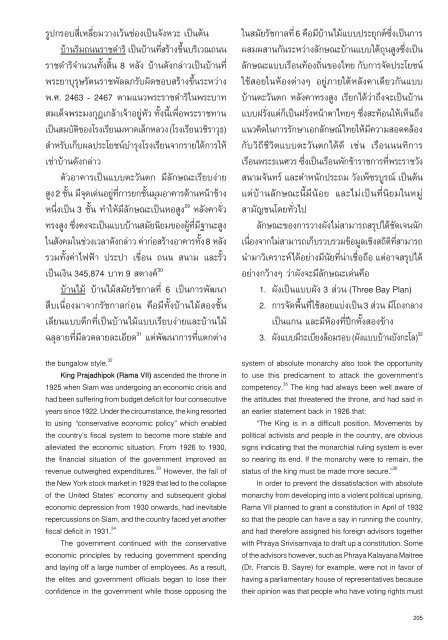บ้านเรือนถิ่นไทยในช่วงเจ็ดทศวรรษ 2489-2559
Create successful ePaper yourself
Turn your PDF publications into a flip-book with our unique Google optimized e-Paper software.
รูปกรอบสี่เหลี่ยมวางเว้นช่องเป็นจังหวะ เป็นต้น<br />
บ้านริมถนนราชดำริ เป็นบ้านที่สร้างขึ้นบริเวณถนน<br />
ราชดำริจำนวนทั้งสิ้น 8 หลัง บ้านดังกล่าวเป็นบ้านที่<br />
พระยาบุรุษรัตนราชพัลลภรับผิดชอบสร้างขึ้นระหว่าง<br />
พ.ศ. 2463 - 2467 ตามแนวพระราชดำริในพระบาท<br />
สมเด็จพระมงกุฎเกล้าเจ้าอยู่หัว ทั้งนี้เพื่อพระราชทาน<br />
เป็นสมบัติของโรงเรียนมหาดเล็กหลวง (โรงเรียนวชิราวุธ)<br />
สำหรับเก็บผลประโยชน์บำรุงโรงเรียนจากรายได้การให้<br />
เช่าบ้านดังกล่าว<br />
ตัวอาคารเป็นแบบตะวันตก มีลักษณะเรียบง่าย<br />
สูง 2 ชั้น มีจุดเด่นอยู่ที่การยกชั้นมุมอาคารด้านหน้าข้าง<br />
หนึ่งเป็น 3 ชั้น ทำให้มีลักษณะเป็นหอสูง 29 หลังคาจั่ว<br />
ทรงสูง ซึ่งคงจะเป็นแบบบ้านสมัยนิยมของผู้ที่มีฐานะสูง<br />
ในสังคมในช่วงเวลาดังกล่าว ค่าก่อสร้างอาคารทั้ง 8 หลัง<br />
รวมทั้งค่าไฟฟ้า ประปา เขื่อน ถนน สนาม และรั้ว<br />
เป็นเงิน 345,874 บาท 9 สตางค์30<br />
บ้านไม้ บ้านไม้สมัยรัชกาลที่ 6 เป็นการพัฒนา<br />
สืบเนื่องมาจากรัชกาลก่อน คือมีทั้งบ้านไม้สองชั้น<br />
เลียนแบบตึกที่เป็นบ้านไม้แบบเรียบง่ายและบ้านไม้<br />
ฉลุลายที่มีลวดลายละเอียด 31 แต่พัฒนาการที่แตกต่าง<br />
the bungalow style. 32<br />
King Prajadhipok (Rama VII) ascended the throne in<br />
1925 when Siam was undergoing an economic crisis and<br />
had been suffering from budget deficit for four consecutive<br />
years since 1922. Under the circumstance, the king resorted<br />
to using “conservative economic policy” which enabled<br />
the country’s fiscal system to become more stable and<br />
alleviated the economic situation. From 1926 to 1930,<br />
the financial situation of the government improved as<br />
revenue outweighed expenditures. 33 However, the fall of<br />
the New York stock market in 1929 that led to the collapse<br />
of the United States’ economy and subsequent global<br />
economic depression from 1930 onwards, had inevitable<br />
repercussions on Siam, and the country faced yet another<br />
fiscal deficit in 1931. 34<br />
The government continued with the conservative<br />
economic principles by reducing government spending<br />
and laying off a large number of employees. As a result,<br />
the elites and government officials began to lose their<br />
confidence in the government while those opposing the<br />
ในสมัยรัชกาลที่ 6 คือมีบ้านไม้แบบประยุกต์ซึ่งเป็นการ<br />
ผสมผสานกันระหว่างลักษณะบ้านแบบใต้ถุนสูงซึ่งเป็น<br />
ลักษณะแบบเรือนท้องถิ่นของไทย กับการจัดประโยชน์<br />
ใช้สอยในห้องต่างๆ อยู่ภายใต้หลังคาเดียวกันแบบ<br />
บ้านตะวันตก หลังคาทรงสูง เรียกได้ว่าถึงจะเป็นบ้าน<br />
แบบฝรั่งแต่ก็เป็นฝรั่งหน้าตาไทยๆ ซึ่งสะท้อนให้เห็นถึง<br />
แนวคิดในการรักษาเอกลักษณ์ไทยให้มีความสอดคล้อง<br />
กับวิถีชีวิตแบบตะวันตกได้ดี เช่น เรือนนนทิการ<br />
เรือนพระธเนศวร ซึ่งเป็นเรือนพักข้าราชการที่พระราชวัง<br />
สนามจันทร์ และตำหนักประถม วังเพ็ชรบูรณ์ เป็นต้น<br />
แต่บ้านลักษณะนี้มีน้อย และไม่เป็นที่นิยมในหมู่<br />
สามัญชนโดยทั่วไป<br />
ลักษณะของการวางผังไม่สามารถสรุปได้ชัดเจนนัก<br />
เนื่องจากไม่สามารถเก็บรวบรวมข้อมูลเชิงสถิติที่สามารถ<br />
นำมาวิเคราะห์ได้อย่างมีนัยที่น่าเชื่อถือ แต่อาจสรุปได้<br />
อย่างกว้างๆ ว่าผังจะมีลักษณะเด่นคือ<br />
1. ผังเป็นแบบผัง 3 ส่วน (Three Bay Plan)<br />
2. การจัดพื้นที่ใช้สอยแบ่งเป็น 3 ส่วน มีโถงกลาง<br />
เป็นแกน และมีห้องที่ปีกทั้งสองข้าง<br />
3. ผังแบบมีระเบียงล้อมรอบ (ผังแบบบ้านบังกะโล) 32<br />
system of absolute monarchy also took the opportunity<br />
to use this predicament to attack the government’s<br />
competency. 35 The king had always been well aware of<br />
the attitudes that threatened the throne, and had said in<br />
an earlier statement back in 1926 that:<br />
“The King is in a difficult position. Movements by<br />
political activists and people in the country, are obvious<br />
signs indicating that the monarchial ruling system is ever<br />
so nearing its end. If the monarchy were to remain, the<br />
status of the king must be made more secure.” 36<br />
In order to prevent the dissatisfaction with absolute<br />
monarchy from developing into a violent political uprising,<br />
Rama VII planned to grant a constitution in April of 1932<br />
so that the people can have a say in running the country,<br />
and had therefore assigned his foreign advisors together<br />
with Phraya Srivisarnvaja to draft up a constitution. Some<br />
of the advisors however, such as Phraya Kalayana Maitree<br />
(Dr. Francis B. Sayre) for example, were not in favor of<br />
having a parliamentary house of representatives because<br />
their opinion was that people who have voting rights must<br />
205


















